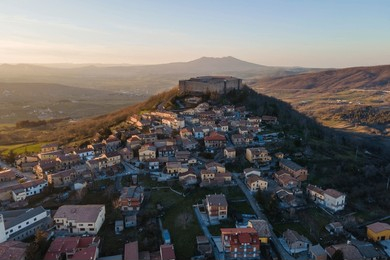As people begin to search for new places to call home, they often wonder how much land a small town takes up. The answer is not as simple as it may seem.
Small towns vary in size and acreage, but they all offer unique benefits to those who live there.
The average land area of a small town is approximately 3.5 square miles. This translates to about 2,240 acres.
In this article, I will explore the question of how many acres is a small town and provide a guide to help you better understand the land area of these charming communities.
Defining a Small Town
Before we dive into the land area of small towns, it’s important to define what we mean by a “small town.”

The definition can vary depending on who you ask, but generally, a small town is a community with a population of less than 10,000 people.
These towns often have a central business district, a few grocery stores, and a handful of restaurants and shops.
They are typically located in rural areas or on the outskirts of larger cities.
How many acres are in a small town?
The land area of a small town can vary greatly depending on various factors such as location, population density, and other factors. As a result, there is no standard acreage that defines a small town.
However, it’s worth noting that the U.S. Census Bureau defines an urban area as a densely populated area with a population of 2,500 or more. An urban area may include a small town or several small towns clustered together.
In terms of acreage, the land area of a small town can range from a few hundred acres to several thousand acres. However, if you want to learn how big is 1000 acres. For example, the town of Burns, Oregon, has a land area of approximately 1,275 square miles, which is equivalent to over 816,000 acres. On the other hand, the town of Bethel, Vermont, has a land area of only 44.5 square miles, which is equivalent to approximately 28,480 acres.
It’s also important to note that the land area of a small town can be categorized as either rural or urban. Rural small towns tend to have a larger land area, as they are often located in areas with more open space. These towns may have more agricultural land, forests, or natural resources, which can affect their land area. Urban small towns, on the other hand, tend to have a smaller land area. These towns are often located in more densely populated areas and may be surrounded by suburbs or other small towns.
Rural vs. Urban Small Towns
Rural small towns tend to have a larger land area, as they are often located in areas with more open space.

These towns may have more agricultural land, forests, or natural resources, which can affect their land area. Rural small towns also tend to have lower population densities, which allows for more space between homes and businesses.
Urban small towns, on the other hand, tend to have a smaller land area. These towns are often located in more densely populated areas and may be surrounded by suburbs or other small towns.
Urban small towns may have more commercial and industrial development, which can limit the amount of available land.
Benefits of Living in a Small Town
Regardless of their land area, small towns offer many benefits to those who live there. These benefits include:
A strong sense of community: Small towns are often close-knit communities where everyone knows each other. This can create a strong sense of belonging and connectedness.
Lower cost of living: Small towns typically have a lower cost of living than larger cities. This can make it easier to afford a home and other expenses.
More outdoor activities: Small towns are often located in areas with more natural resources, such as forests, lakes, and parks. This can provide more opportunities for outdoor activities like hiking, fishing, and camping.
Related: How Big Is 40 Acres?
Less traffic and noise: Small towns tend to have less traffic and noise pollution than larger cities, which can make for a quieter, more peaceful living environment.
Disadvantages of Living in a Small Town
While there are many benefits to living in a small town, there are also some disadvantages to consider. These include:
Limited job opportunities: Small towns may have fewer job opportunities than larger cities, especially in certain industries.
Less cultural diversity: Small towns tend to have less cultural diversity than larger cities, which can limit exposure to different cultures and perspectives.
Limited access to amenities: Small towns may have fewer amenities than larger cities, such as shopping centers, restaurants, and entertainment venues.
Limited healthcare options: Small towns may have fewer healthcare options than larger cities, which can make it more difficult to access specialized medical care.
Things to Consider When Moving to a Small Town
If you are considering moving to a small town, there are several things to consider. These include:
Job opportunities: Make sure there are job opportunities in your field before moving to a small town.
Cost of living: Research the cost of living in the area to make sure it is affordable for you.
Amenities: Consider what amenities are important to you, such as shopping centers, restaurants, and entertainment venues.
Healthcare options: Research healthcare options in the area to make sure you can access the medical care you need.
Climate: Consider the climate of the area and whether it is a good fit for you.
Tips for Adjusting to Small-Town Life
Adjusting to small-town life can be a big change, especially if you are used to living in a larger city. Here are some tips to help you adjust:
Get involved in the community: Join local organizations or volunteer to meet new people and get involved in the community.
Be open-minded: Embrace the slower pace of life and be open to trying new things.
Find hobbies and activities: Explore the natural resources in the area and find hobbies and activities that interest you.
Stay connected: Use technology to stay connected with friends and family who may live in other areas.
Related: How Many Acres in a City Block?
FAQs
What is the size of a small town?
The size of a small town can vary depending on various factors such as location, population density, and other factors. Generally, a small town is considered to have a population of less than 10,000 people.
How many acres is a normal city?
The land area of a city can vary greatly depending on its location, population density, and other factors. A “normal” city can range from a few square miles to several hundred square miles. For example, New York City has a land area of 468.9 square miles, which is equivalent to over 299,000 acres.
How big is a small rural town?
A small rural town can have a land area ranging from a few hundred acres to several thousand acres. These towns are often located in areas with more open space and may have more agricultural land, forests, or natural resources.
What are the characteristics of a small town?
Small towns are often characterized by a close-knit community, a slower pace of life, and a more relaxed atmosphere than larger cities. They may also have a distinct cultural identity and a sense of history or tradition. Small towns may have a central business district, residential neighborhoods, and public spaces such as parks and community centers.
What is a town in the USA?
In the United States, a town is a type of municipal corporation with a population of less than 10,000 people. Towns have their own local government and may have their own police department, fire department, and other municipal services. The specific laws and regulations governing towns can vary depending on the state and region.